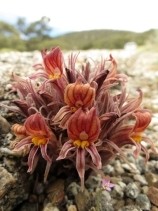California broomrape
(Aphyllon californicum californicum)

Description
Orobanche californica, known by the common name California broomrape, is a species of broomrape. It is a parasitic plant growing attached to the roots of other plants, usually members of the Asteraceae. Orobanche californica is native to western North America from British Columbia and Idaho, through California and Nevada, to Baja California. It is found in many types of habitats. It has been noted to be associated with California goldenrod (Solidago californica) and sagebrush (Artemisia tridentata). This plant arises from a thick root and grows erect to a maximum height near 35 centimetres (14 in), with one stem or a cluster of several. As a parasite taking its nutrients from a host plant, it lacks leaves and chlorophyll. It is light to dark purple in color and coated with glandular hairs. The inflorescence is an elongated or branching array of several flowers. Each flower is tubular, up to 5 centimeters long, and pale pink, yellowish, or purple in color, sometimes with stark veining. The fruit is a capsule containing minute seeds. Broomrapes are generally small, only 10–60 centimetres (4–24 inches) tall depending on species. They are best recognized by the yellow- to straw-coloured stems completely lacking chlorophyll, bearing yellow, white, or blue snapdragon-like flowers. The flower shoots are scaly, with a dense terminal spike of 10-20 flowers in most species, although single in one-flowered broomrape (Orobanche uniflora). The leaves are merely triangular scales. The seeds are minute, tan or brown, blackening with age. These plants generally flower from late winter to late spring. When they are not flowering, no part of the plants is visible above the surface of the soil.
Taxonomic tree:







